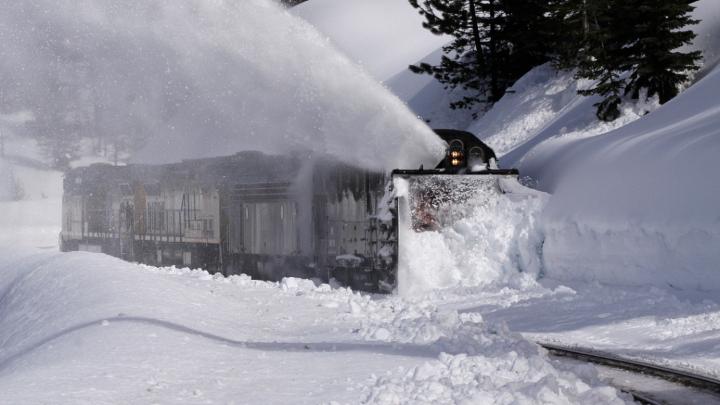Demand for Rail Service to Increase, but Challenges Lead to Questions
Winter weather prompted 13-day closure of UP railroad along I-80
- Published In: Other News & Features
- Last Updated: Jul 20, 2023

A Rotary snowplow, considered a “big gun" in Union Pacific’s snow-fighting efforts, barrels through snow on track in California. (Courtesy photo from Union Pacific)

By Carrie Haderlie
Special to the Wyoming Truth
Lawmakers are asking if Union Pacific will be able to meet demand for increased service in coming years, following rail closures during a record winter season and projected growth in Wyoming’s trona industry.
During a Joint Minerals, Business and Economic Development committee meeting Tuesday in Rock Springs, Nathan Anderson, senior director of public affairs for the Union Pacific, told lawmakers that winter was tough for the railroad.
“[Winter] was a real challenge for us on a number of fronts. Hiring challenges persisted,” Anderson said. “Road closures and railroad closures became, unfortunately, routine, and that exacerbated issues. Our main line across I-80 was closed multiple times, in one case for 13 days before we could dig out that train.”
Operations went back to normal in spring and summer, he said. But Rep. Jon Conrad (R-Mountain View) pointed out that Wyoming’s weather impacts a multitude of industries, and asked how Union Pacific will change practices following the winter of 2022-23.
“What are you going to do differently this year, this coming winter, that you didn’t do last year?” Conrad asked.
Anderson said the railroad cannot predict where, when or how severe weather will impact operations, but that the company works closely with the Wyoming Department of Transportation and the state’s Highway Patrol to “quickly, efficiently and safely” reopen lines.
“We have learned some things,” he said. “At some point, though, you literally are at the mercy of the elements.”
‘We rely on rail’
Demand for rail services in southeastern Wyoming will likely increase in coming months, Rep. Scott Heiner (R-Green River) said, referring to trona mine expansion in the region. One company called Solvay, for example, announced in November its plans to resume construction and expansion of a soda ash plant near Green River. Heiner asked whether the UP could handle freight needs in the event trona production increases 40-50%.
“We have a lot of investment that is going to happen in southwestern Wyoming,” Heiner said. “It’s a factor of millions of dollars in the next few years.”
Anderson had previously said the UP is working on its “hiring challenges,” and Heiner acknowledged that he appreciates the company “getting more boots on the ground.”
He then asked for a Wyoming-specific dollar amount the UP plans to invest in Wyoming’s railway.
“Could you give us an idea of what, capital-wise, you are planning to handle the additional material that needs to be transported out of this area? It is vital to our economy,” Heiner said.
In 2022, UP invested $55 million in capital in the state of Wyoming, Anderson said, in addition to salaries paid. He could not give the committee a state-specific projected capital investment for future years, but said the company plans about $3.6 billion in “network investment,” or improvements, across all UP states.
During public comment, Travis Deti, executive director of the Wyoming Mining Association, said that his members rely on rail, but “service was dreadful in the last year.”
“This state runs on extraction, and we rely on rail,” Deti said. “We need reliable rail service.”
Service has improved in the last several months, Deti said, adding that companies like Union Pacific and BNSF have responded to complaints of coal-moving disruptions in the Powder River Basin.
“We are moving coal again,” he said. “But are we where we need to be? Not yet.
In the trona industry, we share the same concerns. [Southeastern Wyoming] is going to see significant growth in production, and we need that reliable rail service to get it out. There are concerns right now as to whether the railroad will be able to handle that.”
Wyoming AFL CIO Executive Director Tammy Johnson also addressed the committee, saying Wyoming’s rail workers are most affected by delays, weather and staffing issues.
“Our train workers are still out there having a really difficult time,” Johnson said. “I talked to one of our lead engineers out of the Cheyenne terminal, and he is working 11 days on, four days off. He doesn’t have a choice. That is his job.”
Railroad employees, she continued, are often obligated by decisions from company hubs in metropolitan areas outside of Wyoming.
“We do need legislation. Rail workers are not allowed to stand up for themselves and say, ‘Enough is enough. We are not coming to work today.’ We saw that happen this last winter, when they were forced to go back to work the next day,” she said. “They don’t get to go on strike or tell their employers, ‘This is too grueling. We can’t take it’.”













